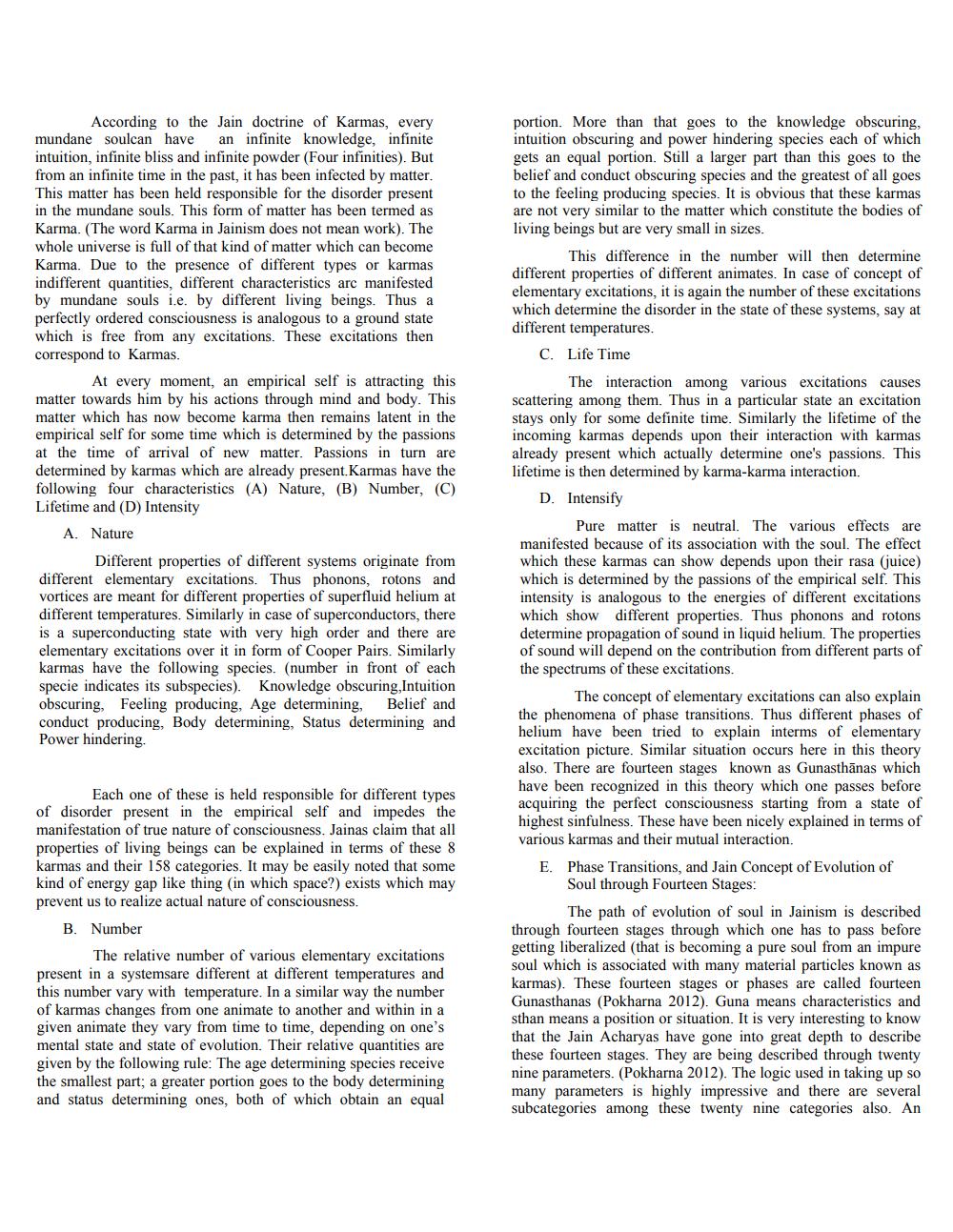Book Title: Quantum Field Theory like model of consciousness in Jainism Author(s): Surendra Singh Pokharna Publisher: Surendra Singh Pokharna View full book textPage 2
________________ According to the Jain doctrine of Karmas, every mundane soulcan have an infinite knowledge, infinite intuition, infinite bliss and infinite powder (Four infinities). But from an infinite time in the past, it has been infected by matter. This matter has been held responsible for the disorder present in the mundane souls. This form of matter has been termed as Karma. (The word Karma in Jainism does not mean work). The whole universe is full of that kind of matter which can become Karma. Due to the presence of different types or karmas indifferent quantities, different characteristics arc manifested by mundane souls i.e. by different living beings. Thus a perfectly ordered consciousness is analogous to a ground state which is free from any excitations. These excitations then correspond to Karmas. At every moment, an empirical self is attracting this matter towards him by his actions through mind and body. This matter which has now become karma then remains latent in the empirical self for some time which is determined by the passions at the time of arrival of new matter. Passions in turn are determined by karmas which are already present.Karmas have the following four characteristics (A) Nature, (B) Number, (C) Lifetime and (D) Intensity A. Nature Different properties of different systems originate from different elementary excitations. Thus phonons, rotons and vortices are meant for different properties of superfluid helium at different temperatures. Similarly in case of superconductors, there is a superconducting state with very high order and there are elementary excitations over it in form of Cooper Pairs. Similarly karmas have the following species. (number in front of each specie indicates its subspecies). Knowledge obscuring, Intuition obscuring, Feeling producing, Age determining. Belief and conduct producing, Body determining, Status determining and Power hindering portion. More than that goes to the knowledge obscuring, intuition obscuring and power hindering species each of which gets an equal portion. Still a larger part than this goes to the belief and conduct obscuring species and the greatest of all goes to the feeling producing species. It is obvious that these karmas are not very similar to the matter which constitute the bodies of living beings but are very small in sizes. This difference in the number will then determine different properties of different animates. In case of concept of elementary excitations, it is again the number of these excitations which determine the disorder in the state of these systems, say at different temperatures. C. Life Time The interaction among various excitations causes scattering among them. Thus in a particular state an excitation stays only for some definite time. Similarly the lifetime of the incoming karmas depends upon their interaction with karmas already present which actually determine one's passions. This lifetime is then determined by karma-karma interaction. D. Intensify Pure matter is neutral. The various effects are manifested because of its association with the soul. The effect which these karmas can show depends upon their rasa (juice) which is determined by the passions of the empirical self. This intensity is analogous to the energies of different excitations which show different properties. Thus phonons and rotons determine propagation of sound in liquid helium. The properties of sound will depend on the contribution from different parts of the spectrums of these excitations. The concept of elementary excitations can also explain the phenomena of phase transitions. Thus different phases of helium have been tried to explain interms of elementary excitation picture. Similar situation occurs here in this theory also. There are fourteen stages known as Gunasthānas which have been recognized in this theory which one passes before acquiring the perfect consciousness starting from a state of highest sinfulness. These have been nicely explained in terms of various karmas and their mutual interaction. E. Phase Transitions, and Jain Concept of Evolution of Soul through Fourteen Stages: The path of evolution of soul in Jainism is described through fourteen stages through which one has to pass before getting liberalized that is becoming a pure soul from an impure soul which is associated with many material particles known as karmas). These fourteen stages or phases are called fourteen Gunasthanas (Pokharna 2012). Guna means characteristics and sthan means a position or situation. It is very interesting to know that the Jain Acharyas have gone into great depth to describe these fourteen stages. They are being described through twenty nine parameters. (Pokharna 2012). The logic used in taking up so many parameters is highly impressive and there are several subcategories among these twenty nine categories also. An Each one of these is held responsible for different types of disorder present in the empirical self and impedes the manifestation of true nature of consciousness. Jainas claim that all properties of living beings can be explained in terms of these 8 karmas and their 158 categories. It may be easily noted that some kind of energy gap like thing in which space?) exists which may prevent us to realize actual nature of consciousness. B. Number The relative number of various elementary excitations present in a systemsare different at different temperatures and this number vary with temperature. In a similar way the number of karmas changes from one animate to another and within in a given animate they vary from time to time, depending on one's mental state and state of evolution. Their relative quantities are given by the following rule: The age determining species receive the smallest part; a greater portion goes to the body determining and status determining ones, both of which obtain an equalPage Navigation
1 2 3 4 5 6
